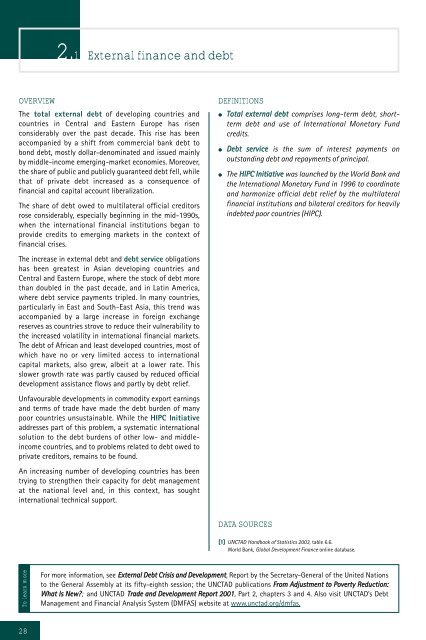Development and Globalization: - Unctad
Development and Globalization: - Unctad
Development and Globalization: - Unctad
Create successful ePaper yourself
Turn your PDF publications into a flip-book with our unique Google optimized e-Paper software.
OVERVIEW DEFINITIONS<br />
The total external debt of developing countries <strong>and</strong><br />
countries in Central <strong>and</strong> Eastern Europe has risen<br />
considerably over the past decade. This rise has been<br />
accompanied by a shift from commercial bank debt to<br />
bond debt, mostly dollar-denominated <strong>and</strong> issued mainly<br />
by middle-income emerging-market economies. Moreover,<br />
the share of public <strong>and</strong> publicly guaranteed debt fell, while<br />
that of private debt increased as a consequence of<br />
financial <strong>and</strong> capital account liberalization.<br />
The share of debt owed to multilateral official creditors<br />
rose considerably, especially beginning in the mid-1990s,<br />
when the international financial institutions began to<br />
provide credits to emerging markets in the context of<br />
financial crises.<br />
The increase in external debt <strong>and</strong> debt service obligations<br />
has been greatest in Asian developing countries <strong>and</strong><br />
Central <strong>and</strong> Eastern Europe, where the stock of debt more<br />
than doubled in the past decade, <strong>and</strong> in Latin America,<br />
where debt service payments tripled. In many countries,<br />
particularly in East <strong>and</strong> South-East Asia, this trend was<br />
accompanied by a large increase in foreign exchange<br />
reserves as countries strove to reduce their vulnerability to<br />
the increased volatility in international financial markets.<br />
The debt of African <strong>and</strong> least developed countries, most of<br />
which have no or very limited access to international<br />
capital markets, also grew, albeit at a lower rate. This<br />
slower growth rate was partly caused by reduced official<br />
development assistance flows <strong>and</strong> partly by debt relief.<br />
Unfavourable developments in commodity export earnings<br />
<strong>and</strong> terms of trade have made the debt burden of many<br />
poor countries unsustainable. While the HIPC Initiative<br />
addresses part of this problem, a systematic international<br />
solution to the debt burdens of other low- <strong>and</strong> middleincome<br />
countries, <strong>and</strong> to problems related to debt owed to<br />
private creditors, remains to be found.<br />
An increasing number of developing countries has been<br />
trying to strengthen their capacity for debt management<br />
at the national level <strong>and</strong>, in this context, has sought<br />
international technical support.<br />
To learn more<br />
28<br />
2.1 External finance <strong>and</strong> debt<br />
● Total external debt comprises long-term debt, shortterm<br />
debt <strong>and</strong> use of International Monetary Fund<br />
credits.<br />
● Debt service is the sum of interest payments on<br />
outst<strong>and</strong>ing debt <strong>and</strong> repayments of principal.<br />
● The HIPC Initiative was launched by the World Bank <strong>and</strong><br />
the International Monetary Fund in 1996 to coordinate<br />
<strong>and</strong> harmonize official debt relief by the multilateral<br />
financial institutions <strong>and</strong> bilateral creditors for heavily<br />
indebted poor countries (HIPC).<br />
DATA SOURCES<br />
[1] UNCTAD H<strong>and</strong>book of Statistics 2003, table 6.6.<br />
World Bank, Global <strong>Development</strong> Finance online database.<br />
For more information, see External Debt Crisis <strong>and</strong> <strong>Development</strong>, Report by the Secretary-General of the United Nations<br />
to the General Assembly at its fifty-eighth session; the UNCTAD publications From Adjustment to Poverty Reduction:<br />
What Is New?; <strong>and</strong> UNCTAD Trade <strong>and</strong> <strong>Development</strong> Report 2001, Part 2, chapters 3 <strong>and</strong> 4. Also visit UNCTAD’s Debt<br />
Management <strong>and</strong> Financial Analysis System (DMFAS) website at www.unctad.org/dmfas.

















